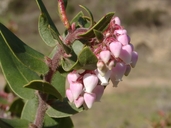Taxon Report
Arctostaphylos pajaroensis AdamsPajaro manzanita |
 Lynn Overtree |
Taxon Summary
Arctostaphylos pajaroensis, commonly known as Pajaro manzanita, is a perennial evergreen shrub in the Ericaceae that is found only in California. It occurs within Chaparral, growing at elevations from 30 to 760 meters. Arctostaphylos pajaroensis is ranked 1B.1, Plants Rare, Threatened or Endangered in California and Elsewhere; Seriously threatened in California.Classification
|
Scientific Name: |
Arctostaphylos pajaroensis Adams |
|
Common Name: |
Pajaro manzanita |
| Family: | Ericaceae |
| Element Code: | PDERI04100 |
| USDA Plants Symbol: | ARPA3 |
|
Synonyms/Other Names: |
|
Ecology and Life History
| Lifeform: | perennial evergreen shrub |
| Blooming Period: Dec-Mar | Dec-Mar |
| Elevation: | 30-760 (100-2495) |
| General Habitats: | Chaparral |
| Microhabitat: | |
| Microhabitat Details: |
Conservation Status
| CA Rare Plant Rank: | 1B.1 |
| Global Rank: | G1 |
|
State Rank: |
S1 |
| State List: | None |
| Fed List: | None |
| Other Status: | BLM_S; SB_UCSC |
|
CRPR Changes: |
|
Occurrence Data from the CNDDB
| Total Occurrences: | 28 |
| Element Occurrence Ranks: | |
| Excellent (A) | 2 |
| Good (B) | 2 |
| Fair (C) | 2 |
| Poor (D) | 0 |
| None (X) | 2 |
| Unknown (U) | 20 |
| California Endemic: True | |
| California Counties and Islands: Name (Code) | |
| Monterey (MNT), San Benito (SBT), Santa Cruz (SCR)* | |
| Quads: Name (Quad Code) | |
| Hollister (3612174), Marina (3612167), Monterey (3612158), Moss Landing (3612177), Mt. Harlan (3612164), Prunedale (3612176), Salinas (3612166), Seaside (3612157), Watsonville East (3612186), Watsonville West (3612187) | |
Threat List Data from the CNDDB
| Threat List Total: | 9 | |
| EOs with Threat Listed: | Total EOs | % of EOs |
| 13 | 46 % | |
| Development | 8 | 28% |
| Improper burning regime | 3 | 10% |
| Road/trail construction/maint. | 3 | 10% |
| Agriculture | 2 | 7% |
| ORV activity | 2 | 7% |
| Other | 1 | 3% |
| Recreational use (non-ORV) | 1 | 3% |
| Non-native plant impacts | 1 | 3% |
| Disease | 1 | 3% |
Citation
California Native Plant Society, Rare Plant Program. 2025. Rare Plant Inventory (online edition, v9.5.1). Website https://www.rareplants.cnps.org [accessed 21 December 2025].